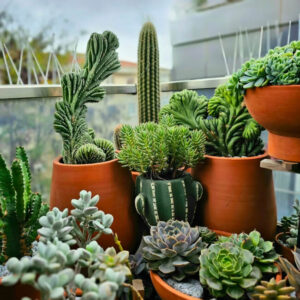Camellia sasanqua is a beautiful flowering shrub that is native to Japan, China, and Korea. Its popularity in Australian gardens is due to its ability to tolerate the country's climate and soil conditions.
This guide will provide all the information you need to grow Camellia sasanqua and make the most of its stunning flowers through the cooler months, which can appear either in autumn or spring depending on what part of the country you’re in.
More...
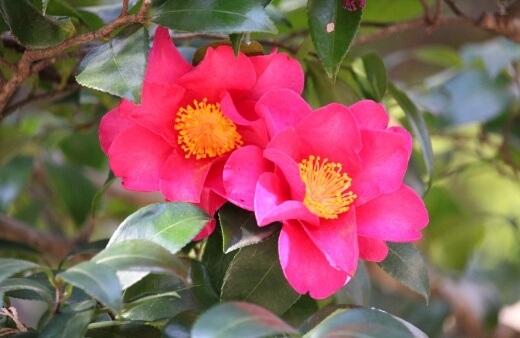
Family: | Theaceae |
|---|---|
Genus: | Camellia |
Species: | C. sasanqua |
Common Name: | Sasanqua Camellia |
Origin: | Japan, Korea, and China |
Location: | Outdoor |
Type: | Shrub |
Growth: | 2m tall x 2m wide |
Sun requirements: | Part shade or full sun |
Foliage Colour: | Emerald green |
Flower Colour: | White, pink, red, or mixed |
Flowering: | Late autumn to early spring |
Edible Parts: | Not edible |
Maintenance level: | Low |
Poisonous for pets: | Not considered toxic to pets |
What is Camellia sasanqua?
Camellia sasanqua is a flowering shrub, known for its beautiful, fragrant blooms, which can be seen in a range of colours, including pink, white, and red. However, its popularity is much more about the depth of colour its flowers can offer, than its evergreen form, with red and white striped blooms common in many cultivars.
Camellia sasanqua is an evergreen shrub that can grow up to 3 metres in height and 2 metres in width.
Sasanqua Camellia’s Natural Habitat
Camellia sasanqua is native to Japan, China, and Korea. It prefers a mild, humid climate and can grow in a range of soil types, including acidic, alkaline, and neutral soils.
It is related to common camellias, which are used to make tea, and while much less flavourful, can actually be used itself by picking young leaves as they emerge and drying them slowly in the sun.
Growing Camellia sasanqua
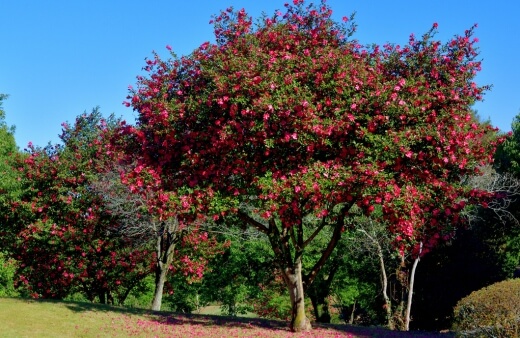
Camellia sasanqua can be planted at any time of the year, but it is best to plant it in autumn or early spring. Choose a spot in your garden that is sheltered from strong winds and receives partial shade or dappled sunlight.
Dig a hole that is twice as wide as the root ball and slightly deeper, then line the base of the hole with good-quality organic compost.
Soil & Drainage
Camellia sasanqua prefers well-draining soil that is rich in organic matter. If your soil is heavy clay or sandy, you can improve it by adding compost, aged manure, or well-rotted leaf litter.
It is essential to ensure the soil is not waterlogged, as this can cause root rot.
Light & Temperature
Camellia sasanqua prefers partial shade or dappled sunlight. It can tolerate full sun but may require additional watering in hot weather. Camellia sasanqua can tolerate a range of temperatures, but it is best to protect it from frost and strong winds.
How Often to Water Sasanqua Camellia
Camellia sasanqua requires regular watering, especially during the summer months. Water your plant deeply once a week, or more often if the soil is dry. It is essential to avoid overwatering, as this can cause root rot, which will lead to bud drop, and can defoliate plants completely.
How to Propagate Camellia sasanqua
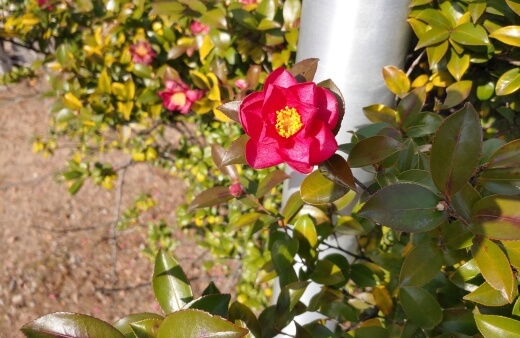
Propagating Camellia sasanqua from Seeds
Camellia sasanqua can be propagated from seed, but it is a slow and challenging process. Collect ripe seeds about six months after flowers have dropped, and scrape the flesh away.
Leave them to dry for a day or two, then clean off any remaining flesh from the seed case. Sow them in a really well-drained compost mix, with added perlite.


Get Your Free Guide:
Master Growing Australian Natives eBook
A Must Have Complete Guide for Every Australian Garden
Get Your Free Guide:
Master Growing Australian Natives eBook
A Must Have Complete Guide for Every Australian Garden
Cover the pot with a plastic bag, and secure it with an elastic band to keep humidity in without the need to water constantly. Mist the soil if it dries out, and store it in a warm, bright place, but out of direct light.
The seeds should germinate within 4-6 weeks but keep them in their starter pots for several months, and only move them into a bigger pot when the roots have filled their container.
Plant out into the garden after several repottings, and when plants are at least 1 ft tall.
Camellia sasanqua Propagation from Cuttings
The easiest way to propagate Camellia sasanqua is from cuttings.
- Take a cutting from a healthy plant in late spring or early summer.
- The cutting should be around 10-15 cm long and have at least 2-3 leaf nodes.
- Dip the base of the cutting in rooting hormone and plant it in a well-draining soil mix.
- Keep the soil moist and warm, and the cutting should root within 6-8 weeks.
- Once rooted, allow the cutting to fill its pot with roots, before planting it into a larger pot with a deep root run.
- Keep moist and warm, and plant out when its roots fill a 20-25cm pot.
Caring for Sasanqua Camellia
Mulching
Mulching can help retain moisture in the soil and suppress weed growth around the base of camellias, so even if it's just for that practical consideration it's worth mulching. But it's also useful as a bloom booster, and is much more effective than any liquid fertiliser for the long-term health of a plant.
We add plenty of coffee grounds and used tea bags to our compost, but you can mulch around camellias with tea bags and coffee grounds before they rot down too, adding light acidity and nitrogen to the soil all year round.
Pruning Camellia sasanqua
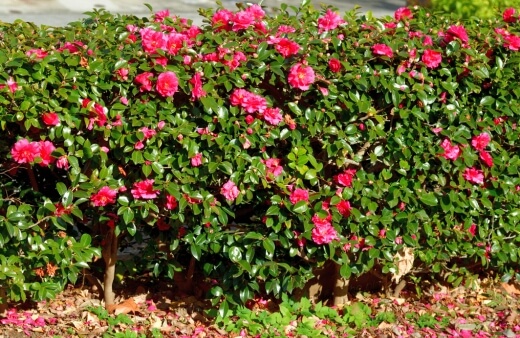
Pruning Camellia sasanqua is best done after the plant has finished flowering. You should trim back any leggy or dead branches to encourage new growth and maintain a good shape. It is also important to remove any diseased or damaged branches to prevent the spread of disease.
For most gardeners, camellias are considered their best when they are tightly pruned into a neat shrub, but for others, clearing out the lower branches to create a small tree is more desirable.
Go for whatever suits you and works in your garden, but be aware that you’ll need to repeat any pruning every year to maintain the shape of formal camellias.
Repotting
Camellia sasanqua is generally not a fussy plant and does not require frequent repotting. However, if you notice that the plant has outgrown its container or the soil has become compacted, it may be time to repot.
The best time to do this is in the early spring before new growth appears. Choose a container that is slightly larger than the current one, and use a well-draining potting mix.
Gently remove the plant from its current container and loosen any tangled roots. Place it in the new container and fill in the space with fresh potting mix, making sure to firm it down gently.
Water the plant well and place it in a bright, sheltered spot for a few days to help it recover.
Sasanqua Camellia Pests and Diseases
Despite being a hardy plant, Camellia sasanqua is susceptible to a few pests and diseases that can damage or kill the plant if left untreated. To prevent pests and diseases, it is important to maintain good plant hygiene and keep the plant healthy by providing it with adequate water and nutrients.
Aphids
Aphids are small green or black insects, typically about 1-2mm long, that suck the chlorophyll from the young shoots of plants, causing stunted growth and yellowing leaves.
They are hard to get rid of, but can be controlled and managed by spraying them using a powerful hose which will interpret their breeding cycle.
Check out our in-depth guide to dealing with aphids here.
Scale insects
Small, round, brown, or black insects called scale insects, have the appearance of hard bumps, and cover themselves in tough secretions to deter predators.
They attach themselves to the leaves and stems, sucking the sap and causing the plant to weaken and die. Either scrape them off by hand or treat them with rubbing alcohol to break down their shells, which kills them nearly instantly.
Find out more about scale insect treatment and prevention here.
Spider mites
Tiny insects that live on the underside of the leaves and spin webs. They can cause leaf damage and yellowing. They are particularly problematic on potted camellias as they thrive in dry conditions.
Keeping your camellias well-watered, but not waterlogged will usually reduce any infestations quickly.
Refer to our guide on how to get rid of spider mites here.
Camellia flower blight
Camellia flower blight is a frustrating fungal disease that causes brown spots on the flowers and can cause them to fall off prematurely. Once this happens, it is usually the end of flowering for that year and can be pretty hard to resolve quickly.
To fix it ahead of next year, prune your camellia back by about a third, regularly cleaning your secateurs between cuts. After about a week, spray the plant with diluted copper fungicide, which should help to treat any remaining infection.
The following year you’ll have a bushier, healthier plant that should flower with full vigour again.
Phytophthora root rot
A soil-borne fungal disease that causes the roots to rot, leading to wilting, yellowing leaves, and eventual death. Once it takes hold, it is hard to detect and is rarely fixable but if you notice yellowing leaves, or the appearance of dry foliage while the soil is wet, check if there is any smell from the roots, or if any roots are black and mushy.
Cut out the affected roots, and treat the whole area with a soil fungicide.
Leaf gall
Leaf gall is a common bacterial disease on camellias that causes swollen and distorted leaves, which can affect the plant's growth and flowering. Remove any affected leaves as soon as you spot them and burn them.
Gall will not kill plants if you keep on top of it, but it can spread to many other species.
Camellia sasanqua Frequently Asked Questions

Can Camellia sasanqua be grown in pots?
Camellia sasanqua can be grown in pots as long as the pot is large enough to accommodate the plant's roots and has good drainage. Use a well-draining potting mix and water the plant regularly.
How often should I fertilise my Camellia sasanqua?
Camellia sasanqua should be fertilised once a month during the growing season (spring to autumn) with a balanced fertiliser. Avoid fertilising in the winter, as the plant is dormant.
When is the best time to prune Camellia sasanqua?
The best time to prune Camellia sasanqua is in the spring, or after it has finished flowering. This will encourage new growth and maintain a good shape.
How much sunlight does Camellia sasanqua need?
Camellia sasanqua prefers partial shade to full sun, depending on the climate. In hot and dry climates, it is best to provide some afternoon shade to prevent leaf scorch.
For more growing tips and its varieties, check out our main Camellia post. Also read our guide on growing Camellia as a hedge if its something you're considering to do so.
Wrapping Up Our Guide to Growing Camellia sasanqua
With the right conditions and care, Camellia sasanqua can produce beautiful flowers for several weeks, and will completely define your garden when little else is flowering.
Remember to provide these flowering shrubs with the right amount of sunlight and keep an eye on the soil conditions. Growing Camellia sasanqua in your own garden doesn't need to be scary.
Like most big flowering shrubs, once they’re in and happy they will be a reliable and rewarding part of your garden for potentially hundreds of years to come.
Published on May 17, 2023 by Maisie Blevins
Last Updated on February 23, 2025

